Kimono Beauties 着物美人
|
Title   • File Name • File Name   • Date • Date   • Position • Position   |
|

Oiran Dochu Procession, Tokyo Jidai Matsuri
|
|

Plum Blossom Queen at Kairakuen StationShe was passing out maps of the garden. It was a nice touch to see two of these kimono beauties greeting us.
|
|

Plum Blossom Queen
|
|

Rear view
|
|

Tekomai geisha costume is partially masculine with trousers instead of skirts. Their right shoulder is "exposed" showing a flower design. They carry a red paper lantern imprinted with their names and use their right hand to drag a wand."Asakusa" is written on her lantern. 手古舞
|
|

Kusatsu Shukuba Festival, Shiga Pref. 大奥夢道中
|
|

Tekomai geisha
|
|

Kusatsu Shukuba Festival, Shiga Pref.
|
|
|
|
|

1. Fuji Murasaki (Purple Wisteria)Dancer's name is Maiko 舞子
|
|

2. Sumidagawa (Sumida River)
|
|
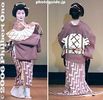
3. Edo no Nigiwai (Liveliness of Edo)
|
|

Court ladies called myobu. 命婦
|
|

Kusatsu Shukuba Festival, Shiga Pref.
|
|
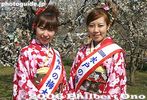
Plum Blossom Queens in Kairakuen, Mito
|
|

Court lady called myobu. 命婦
|
|
|

Plum Blossom Queens in Kairakuen, Mito
|
|
|
|
|

Ariwara no Narihira (825-880) comes to east Japan在原業平 東下り
|
|
|

Yamato Awa Odori
|
|
|
|

Court ladies called uneme. Their kimono have a blue wave design. 釆女釆女
|
|

"Nanohanaya"
|
|
|
|
|

Nohime, wife of Oda Nobunaga. 農姫
|
|
|
|
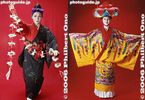
Okinawan KimonoOkinawa is a chain of subtropical islands in southern Japan between Kyushu and Taiwan. It developed its own language and culture while it was an independent kingdom centuries ago. Okinawan kimono, hairstyles, and dances therefore look quite different from the rest of Japan.
On the left is an Okinawan dancer wearing a kimono with her right arm exposed outside the sleeve. The dance is called "Nuchibana" (flower lei) featuring a string of red and white flowers. The dance expresses the feelings of a young woman in love.
The dancer on the right is wearing an Okinawan kimono called the bingata, perhaps Okinawa's most famous kimono. The design is made by applying dyes through a stencil. It was originally worn by Okinawa's royal family members. It is now the costume of a slow-moving Okinawan dance called "Yotsudake."
|
|

Finale: "Hana Utage" (Flower Banquet) 花うたげ
|
|

Tomioka Hachiman tekomai geisha
|
|

Finale: "Hana Utage" (Flower Banquet) 花うたげThis is a maiko.
|
|

Miss Ebisu-bashi Runner-up
|
|

Shinsaibashi Top Lady
|
|
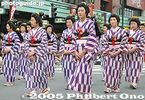
Inner palace women
|
|

Inner palace women
|
|

Another Shinsaibashi Top Lady
|
|
|
|

Shrine maiden on horseback called Munanori Onna. 騎女
|
|
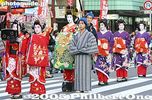
Oiran Dochu Procession. This is definitely the highlight of the festival, and my favorite part of the festival. 花の吉原おいらん道中
|
|

Shrine maiden on horseback called Munanori Onna.
|
|

Kamogawa Odori Geisha Dance, KyotoA scene from the annual Kamogawa Odori dance held in May in Kyoto. She wears a multi-layer kimono whose colors contrast well with each other. This type of kimono was worn by the nobility.
See more photos of this dance here.
|
|

Oiran Dochu Procession
|
|

Oiran Dochu Procession花の吉原おいらん道中
|
|
|
|

Oiran Dochu Procession in front of Kaminarimon Gate, Asakusa.花の吉原おいらん道中
|
|

Oiran Dochu Procession花の吉原おいらん道中
|
|

Oiran Dochu Procession. Her clogs. 花の吉原おいらん道中
|
|
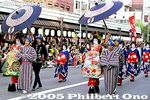
Oiran Dochu Procession. This picture was taken in the 1990s when they had two oiran in the festival. Now they have only one. 花の吉原おいらん道中
|
|

Aoi Festival, KyotoHeld in May, the Aoi (Hollyhock) Festival is one of Kyoto's Big Three festivals. It is a long parade of people dressed in historical costumes from the Heian Period (794-1185) when Kyoto was Japan's capital. Each participant also wears a small branch of hollyhock.
See more photos of this festival here.
|
|

New Year's, Gifu Station
|
|

Coming-of-Age Day, Himeji
|
|

Kimono women going to a convenience store, Ako, Hyogo
|
|

Cigarette break on Coming-of-Age Day. Yes, they can now smoke legally.Ako, Hyogo Pref.
|
|

Oiran Dochu Procession花の吉原おいらん道中
|
|

Aoi Festival, KyotoThe parade proceeds through a long route in Kyoto, taking a few hours.
See more photos of this festival here.
|
|

Edo Geisha, She was the only one with a smile.
|
|

Edo Geisha江戸芸者
|
|

This was the only one who had a smile. The others were quite serious and solemn.
|
|

Mistress Okichi, the infamous mistress of Townsend Harris, America's first ambassador to Japan when he was in Shimoda. Another mistress was provided to Harris' interpreter.Okichi was the infamous mistress of Townsend Harris, America's first ambassador to Japan. Another mistress was provided to Harris' interpreter.
黒船来航・浦賀奉行
|
|

Hagoita Honey poses in Asakusa
|
|

Hagoita Honey
|
|

Hagoita Honey
|
|

Hagoita Honey
|
|

Koenji Awa Odori
|
|
|
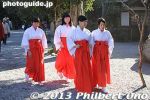
Ise Jingu shrine maidens look the same as any other shrine maidens. They are likely college students hired just for New Year's to sell goods.
|
|

Unlike normal kimono, she wears the obi sashi in the front instead of the back. This is so that she can show off her beautiful obi which would otherwise be covered by the uchikake outer garment.
|
|

Oiran Dochu procession, Tokyo
|
|

Oiran
|
|

Spreading her wings. She did almost the same thing as the first oiran, except for the latter part of the show.
|
|

Oiran
|
|

The person in black is the kurogo attendant.
|
|

She posed for me too.
|
|

Kamuro attendants and oiran courtesan at the Ichiyo Sakura Matsuri Oiran Dochu Procession in Asakusa, Tokyo.
|
|

Back of oiran.
|
|

Oiran stopped and posed for me. How nice of her...
|
|
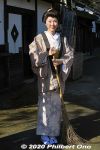
Pretty Edo Period Japanese woman who was sweeping the path. At Edo Wonderland in Nikko, Tochigi.
|
|

Women at Wakamatsu-ya Theater in Edo Wonderland in Nikko, Tochigi. Too bad we didn't have time to catch the show. There's also the Oiran Courtesan Procession. but we didn't see it.
|
|

Saio princess in a palanquin in Meiwa, Mie Prefecture. Very photogenic makeup and costume.
|
|

Saio princess in a palanquin in Meiwa, Mie Prefecture.
|
|
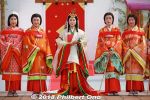
Posing with court ladies called Nyoju (女嬬) who serve in the inner palace (後宮) and take care of the Saio princess' daily living.
|
|

Posing with court ladies called the Uneme (釆女) chosen from an aristocratic family and who was in charge of food and drink.
|
|

Posing with leading court ladies called the Myobu (命婦), assistants who tend to the immediate needs of the Saio princess.
|
|
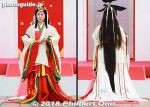
In the end, the Saio princess slowly walked through the palace door that opened for her. Her long, black hair and way of walking were very elegant. After she entered, the doors closed and the festival was over.
|
|

The event attracts a lot of photographers who like to photograph women in kimono. Many of the women are also willing to pose if you ask them.
|
|

The woman might even bring a prop like a red umbrella. Nagahama, Shiga.
|
|

Most of them come with friends or with their mother. Nagahama, Shiga.
|
|

Path to Daitsuji Temple was full of kimono ladies for the Nagahama Kimono Garden Party in Shiga.
|
|

It's almost like Coming-of-Age Day in mid-January when 20-year-olds wear kimono to the official ceremony. But these women can be older than 20. I believe most of them are from Shiga, but a good number are also from nearby prefectures like Gifu, Aichi, and Kyoto. A few were foreigners, probably local English teachers. Nagahama, Shiga.
|
|

This woman was nice because she had a traditional Japanese hairstyle (Shimada style) with her real hair which is rare. There are hairdressers in Japan who are trying to learn, preserve, and promote traditional Japanese hairstyles. It's quite complicated to create and you need really long hair. Nagahama, Shiga.
|
|

Nagahama Kimono Garden Party in mid-Oct. in Shiga Prefecture.
|
|
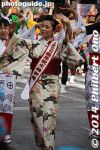
Atsuhime at Shibuya Kagoshima Ohara Festival
|
|

They showed beautiful kimono by models dressed to reflect the past.
|
|

The kimono had flowery designs, but not sure if they were orchids.
|
|
|

They also gave a geisha-like dance performance.
|
|
|
|
|
|
|

Nagata Megumi, Biwako Otsu Tourist Ambassador for 2010, was also in the procession. 永田めぐみ
|
|
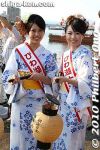
The two Biwako Otsu Tourist Ambassadors for 2010, Inoue Madoka and Nagata Megumi. Selected from among 21 applicants in April 2010. For one year, their job is to promote tourism in Otsu. びわ湖大津観光大使:井上まどか、永田めぐみ
|
|

The festival started at 11:30 am with the Saio princess carried on a palanquin arriving at a small park called Yume no Ogawa next to Ono Elementary School.
|
|

The Saio princess wears a juni-hitoe (12-layer) robe reserved only for Imperial family members. For this festival in 2009, the Saio princess is portrayed by 20-year-old Chiaki Koyama (神山千明) from Shigaraki, Koka.
|
|
|

Saio princess in juni-hitoe kimono.
|
|
|

Chic couple in Kyoto.
|
|
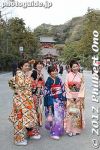
A few kimono ladies on their way to worship at Tsurugaoka Hachimangu Shrine, Kamakura.
|
|
|
|